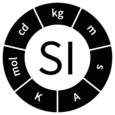SI derived unit
The International System of Units (SI) specifies a set of seven base units from which all other SI units of measurement are derived. Each of these other units (SI derived units) is either dimensionless or can be expressed as a product of (positive or negative, but usually integral) powers of one or more of the base units.
For example, the SI derived unit of area is the square metre (m2), and the SI derived unit of density is the kilogram per cubic metre (kg/m3 or kg m−3). The degree Celsius (see the table below) has a somewhat unclear status, and is arguably an exception to this rule. The names of SI units are written in lowercase. The symbols for units named after persons, however, are always written with an uppercase initial letter (e.g. the symbol for the hertz is "Hz"; but the symbol for the metre is "m").[1]
Derived units with special names
In addition to the two dimensionless derived units radian (rad) and steradian (sr), 20 other derived units have special names.
| Name | Symbol | Quantity | Equivalents | SI base unit Equivalents |
|---|---|---|---|---|
| hertz | Hz | frequency | 1/s | s−1 |
| radian | rad | angle | m/m | dimensionless |
| steradian | sr | solid angle | m2/m2 | dimensionless |
| newton | N | force, weight | kg⋅m/s2 | kg⋅m⋅s−2 |
| pascal | Pa | pressure, stress | N/m2 | kg⋅m−1⋅s−2 |
| joule | J | energy, work, heat | N⋅m C⋅V W⋅s |
kg⋅m2⋅s−2 |
| watt | W | power, radiant flux | J/s V⋅A |
kg⋅m2⋅s−3 |
| coulomb | C | electric charge or quantity of electricity | s⋅A | s⋅A |
| volt | V | voltage, electrical potential difference, electromotive force | W/A J/C |
kg⋅m2⋅s−3⋅A−1 |
| farad | F | electrical capacitance | C/V s/Ω |
kg−1⋅m−2⋅s4⋅A2 |
| ohm | Ω | electrical resistance, impedance, reactance | V/A | kg⋅m2⋅s−3⋅A−2 |
| siemens | S | electrical conductance | 1/Ω A/V |
kg−1⋅m−2⋅s3⋅A2 |
| weber | Wb | magnetic flux | J/A T⋅m2 |
kg⋅m2⋅s−2⋅A−1 |
| tesla | T | magnetic field strength, magnetic flux density | V⋅s/m2 Wb/m2 N/(A⋅m) |
kg⋅s−2⋅A−1 |
| henry | H | inductance | V⋅s/A Ω⋅s Wb/A |
kg⋅m2⋅s−2⋅A−2 |
| degree Celsius | °C | temperature relative to 273.15 K | K | K |
| lumen | lm | luminous flux | cd⋅sr | cd |
| lux | lx | illuminance | lm/m2 | m−2⋅cd |
| becquerel | Bq | radioactivity (decays per unit time) | 1/s | s−1 |
| gray | Gy | absorbed dose (of ionizing radiation) | J/kg | m2⋅s−2 |
| sievert | Sv | equivalent dose (of ionizing radiation) | J/kg | m2⋅s−2 |
| katal | kat | catalytic activity | mol/s | s−1⋅mol |
Examples of derived quantities and units
Other units used with SI
Some other units such as the hour, litre, tonne, and electron volt are not SI units, but are widely used in conjunction with SI units.
Supplementary units
Until 1995, the SI classified the radian and the steradian as supplementary units, but this designation was abandoned and the units were grouped as derived units.[3]
See also
- International System of Quantities (ISQ)
- International System of Units (SI)
- International Vocabulary of Metrology
- Metric prefix
- Metric system
- Non-SI units mentioned in the SI
- Planck units
- SI base unit
References
- ^ http://physics.nist.gov/Pubs/SP811/sec06.html
- ^ International Bureau of Weights and Measures (2006), The International System of Units (SI) (PDF) (8th ed.), ISBN 92-822-2213-6, archived (PDF) from the original on 4 June 2021, retrieved 16 December 2021
- ^ "Resolution 8 of the CGPM at its 20th Meeting (1995)". Bureau International des Poids et Mesures. Retrieved 23 September 2014.
Bibliography
- I. Mills, Tomislav Cvitas, Klaus Homann, Nikola Kallay, IUPAC (June 1993). Quantities, Units and Symbols in Physical Chemistry (2nd ed.). Blackwell Science Inc. p. 72.
{{cite book}}: CS1 maint: multiple names: authors list (link)

